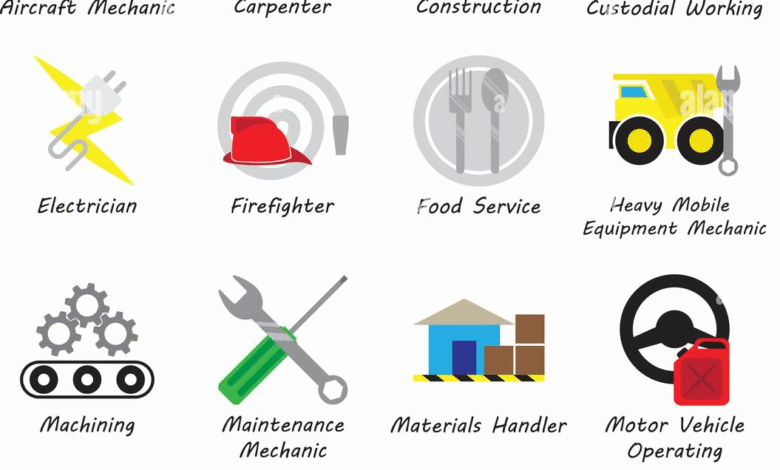Blue-Collar Jobs: Resilient Amid AI Job Threats

Blue-collar jobs are increasingly becoming a secure choice in today’s job market, especially as artificial intelligence (AI) reshapes traditional employment landscapes. Skilled trades like plumbing and electrical work offer stability and resilience against automation’s encroachment, making them an attractive option for those concerned about job security in an AI-driven world. As new job market trends emerge, many young professionals, particularly Gen Z, are redirecting their career aspirations towards these hands-on occupations. This shift is driven by a desire to escape student debt and the fear of obsolescence in roles susceptible to automation. Ultimately, the resurgence of blue-collar work signifies not just a career choice, but a strategic response to the challenges posed by the modern economy and technology.
Blue-collar occupations, encompassing skilled trades and manual labor positions, are witnessing a renaissance in popularity as economic factors and technological advancements shape workforce dynamics. With the emergence of AI and automation, many individuals are pivoting towards practical roles that promise job security and financial independence. This trend is particularly noticeable among younger generations, including Generation Z, which seeks viable alternatives to traditional career paths often hindered by high education costs and economic instability. As market conditions fluctuate, these jobs not only provide stable employment but also cultivate essential skills that are increasingly in demand. In light of these changes, the importance of these hands-on roles is coming to the forefront, establishing a reliable foundation in an unpredictable job market.
The Rise of Blue-Collar Jobs in an AI-Driven World
As artificial intelligence continues to reshape the job landscape, blue-collar jobs are emerging as a strong contender for those seeking reliable and secure employment. Unlike many white-collar sectors that are increasingly vulnerable to automation and AI advancements, positions in skilled trades such as plumbing, electrical work, and HVAC offer a lower risk of displacement. Industry leaders, including notable figures in technology, have echoed this sentiment, emphasizing the importance of hands-on skills that machines cannot easily replicate. The practical nature of blue-collar jobs not only provides individuals with a sense of job security but also fosters opportunities for long-term career growth.
Moreover, the appeal of blue-collar jobs has resonated particularly with Generation Z, who are navigating a job market fraught with uncertainty. As the traditional pathways to stable employment—often requiring costly degrees—become less feasible, many young adults are turning their attention to skilled trades. The Bureau of Labor Statistics projects a significant increase in job openings in these fields, indicating a shift in societal attitudes toward manual labor as a viable and lucrative career option. With training programs becoming more accessible, individuals can gain valuable skills that offer financial stability without the burden of student loan debt.
Skilled Trades: A Path to Job Security Amidst Automation
In the face of rapid technological advancements, skilled trades have emerged as a bastion of job security in the evolving job market. With professions such as electricians, welders, and plumbers ranking high in demand, these blue-collar roles provide significant resistance against the tides of automation that threaten more conventional job roles. According to industry experts, the unique preventive and reparative nature of manual labor ensures that these jobs remain largely insulated from AI encroachment. This trend signifies a newfound respect and recognition for trades that have long been undervalued in society.
Interestingly, the growing interest in skilled trades originates from a variety of economic pressures and changes in values among younger generations. Many members of Generation Z are proving proactive by engaging in skilled trades to avoid the pitfalls that accompany traditional college degrees, which often lead to underemployment and high debt levels. Perspectives around job security have shifted significantly, with young adults favoring practical, hands-on professions that align with their desire for financial independence and a sustainable work-life balance. The increased visibility of trade-related success stories highlights a cultural pivot towards valuing skilled labor as an essential component of a robust economy.
Gen Z’s Interest in Blue-Collar Careers
Generation Z is redefining career aspirations as they navigate a complex job market increasingly influenced by automation and economic uncertainty. Many Gen Z individuals are pivoting toward blue-collar careers, recognizing their potential for job security and financial stability. A recent survey revealed that a significant portion of college-educated young adults are exploring opportunities in skilled trades, motivated by the stark contrast to the often precarious nature of white-collar employment. This generation prioritizes practicality and job availability, which skilled trades reliably offer.
Additionally, the cultural shift towards blue-collar jobs among Gen Z is fueled by a growing recognition of the impact of automation on traditional office roles. The fear of job displacement due to AI has prompted many to consider trade positions as a safer and more stable alternative. As technology changes the landscape of the job market, the current workforce is increasingly inclined to seek out vocations that not only promise longevity but also satisfaction through hands-on work. This generational trend is expected to further amplify the importance of skilled trades as a critical component of the economy.
The Impact of Automation on Job Market Trends
The conversation surrounding automation and its effect on the job market continues to be a pivotal theme in recent years, particularly for blue-collar professions. Advanced technologies, notably artificial intelligence, present both challenges and opportunities in various sectors. While many anticipate that significant portions of the workforce—as much as 6-7%—could be affected by AI, it’s essential to emphasize that skilled trades may be less vulnerable due to the manual skills they require. This factor is critical in shaping job market trends, as consumers begin to favor services that demand human expertise.
As more businesses become aware of the limitations of automation in tasks requiring intricate physical dexterity, the demand for skilled tradespeople is projected to grow exponentially. Positions in construction, mechanics, and maintenance will continue to offer steady employment prospects, even as AI evolves. Additionally, the evolution of trade jobs may include the integration of robotic technology that aids rather than replaces labor, positioning skilled trades as adaptable roles within an increasingly automated landscape.
Collaboration Between Tradespeople and AI
The notion that automation will fully replace blue-collar workers overlooks the crucial capacity for collaboration between skilled tradespeople and AI technologies. Rather than viewing AI as a competitor, many in the trades industry recognize it as an opportunity to enhance their work. For instance, combining skilled labor with AI-driven tools can lead to more efficient problem-solving and improved outcomes in tasks ranging from automotive repair to construction. This partnership allows skilled workers to focus on complex and labor-intensive duties while allowing AI to handle routine operations.
Employers and employees alike are discovering that robotics can serve as a complementary force rather than a substitute in labor-intensive industries. By utilizing AI for diagnostics and preliminary tasks, skilled tradespeople can dedicate their expertise to more intricate components of their craft. This evolution emphasizes the invaluable human element—critical thinking and nuanced decision-making—that machines are far from replicating. As technology continues to advance, the synergy between AI and skilled trades is expected to define the future of work in blue-collar industries.
Preparing for the Future: Training in Skilled Trades
As the job market adapts to the complexities of AI and automation, a growing emphasis on training in skilled trades emerges as a crucial response to employment challenges. Educational systems and institutions are increasingly recognizing the importance of providing vocational training that equips individuals with hands-on skills needed to thrive in the blue-collar workforce. Encouraging early engagement in trade programs not only empowers students with viable career paths but also aligns workforce preparation with the evolving demands of the economy.
With significant career opportunities on the horizon, programs aimed at upskilling and reskilling in the skilled trades sector are paramount. Industry leaders and educators are tasked with advocating for increased visibility and support for trade-based education, ensuring that young adults are aware of the legitimate pathways offered through vocational training. As competition for blue-collar jobs intensifies, equipping individuals with practical skills is fundamental to maintaining a robust workforce capable of meeting the challenges posed by emerging technologies.
Addressing misconceptions about Automation and Blue-Collar Jobs
Despite the ongoing discourse surrounding automation, there exists a pervasive misunderstanding about its actual impact on blue-collar jobs. While candidates in many sectors may feel threatened by the advancements in AI and robotics, skilled trades remain resilient against such changes. It is important to debunk the myth that robots will imminently overtake manual jobs. Expert opinions consistently highlight that the intricate nature of skilled labor—combined with the social value of trades—reinforces the argument that such roles are likely to endure.
The reality remains that although certain lower-skilled jobs may face displacement, skilled manual laborers possess unique capabilities that technology, as it stands, cannot replicate. Professionals in trades acquire a wealth of knowledge and practical experience that cannot be replaced by automation anytime soon. As the conversation evolves, distinguishing between the omnipresent hype of AI and the tangible realities of skilled trades will be crucial in shaping market perceptions and guiding the future workforce in an uncertain employment landscape.
The Future of Employment: Balancing AI and Human Labor
As we stand at the cusp of a new era characterized by rapid technological advancement, the future of employment posits the need for a balanced approach that harmonizes AI integration with human labor. The economy of the future will likely entail a blend of automation and skilled trades, each playing a pivotal role in optimizing production and service delivery. Emerging technologies have the potential to augment human capabilities rather than replace them, prompting industries to embrace innovative solutions that enhance productivity.
Furthermore, while AI may shift the landscape of job availability, the essential characteristics of blue-collar work—problem-solving, adaptability, and human interaction—will continue to secure positions within the workforce. Preparing for future employment scenarios requires a proactive stance on evolving roles, ensuring the labor force remains competitive amidst changing demands. Policies promoting reskilling, vocational training, and collaboration between labor and technology will be instrumental in shaping a prosperous and resilient job market.
Frequently Asked Questions
What are the job security prospects for blue-collar jobs in the age of AI?
Blue-collar jobs are increasingly viewed as secure due to their reliance on manual skills and expertise that are less susceptible to automation. As AI advances, many skilled trades like plumbing, electrical work, and construction are projected to offer long-term job stability because these roles require hands-on labor and improvisation, which AI cannot replicate easily.
How is AI impacting the job market trends for skilled trades?
AI is changing job market trends by highlighting the demand for skilled trades. While there are concerns about job displacement in white-collar sectors, skilled trades continue to show resilience, with job openings expected to increase. This shift is prompting more individuals, especially from Generation Z, to pursue blue-collar careers as a stable alternative.
Why are blue-collar jobs becoming popular among Gen Z careers?
Blue-collar jobs are garnering interest among Gen Z due to economic pressures and concerns about job security linked to AI. Many young adults prefer these careers to avoid student debt and benefit from hands-on work that is less likely to be automated, making skilled trades a compelling choice for financial stability.
What role do skilled trades play in the future labor market affected by automation?
Skilled trades are expected to play a crucial role in the future labor market as automation continues to develop. Trades that require critical thinking, manual dexterity, and complex problem-solving are less vulnerable to automation, allowing for sustained demand even as AI technologies evolve.
What are the most secure blue-collar jobs in the face of automation?
Among the most secure blue-collar jobs are those involving manual labor, such as plumbers, electricians, and construction workers. These roles are less likely to be replaced by AI because they require human intuition and physical skills to perform tasks that machines currently cannot.
How do automation advancements affect job security in the blue-collar sector?
While automation advancements pose challenges, many blue-collar jobs maintain strong job security due to the complex nature of the tasks involved. Roles such as mechanics and HVAC technicians require specialized skills that are not easily automated, suggesting a continued need for human workers in these fields.
What insights did recent surveys provide about blue-collar jobs and Gen Z’s career choices?
Recent surveys indicated a significant shift among Gen Z towards blue-collar jobs, with 42% actively pursuing skilled trades. This trend is driven by concerns about job security amid AI advancements, higher education costs, and the search for practical career paths that lead to financial independence.
Can blue-collar workers collaborate with AI technologies in their jobs?
Yes, blue-collar workers can collaborate with AI technologies to enhance their work processes. For instance, while AI may assist with diagnostics in automotive repair, skilled mechanics will always be needed to perform the physical work, ensuring that AI acts as a complement rather than a replacement.
What is the future outlook for skilled trades in light of AI and automation?
The future outlook for skilled trades remains optimistic despite the rise of AI and automation. As the demand for skilled workers grows and job openings in trades expand, these careers are likely to become a preferred choice for many job seekers looking for security and growth opportunities in the evolving job market.
| Key Point | Details |
|---|---|
| Blue-Collar Jobs on the Rise | Blue-collar jobs are gaining relevance as AI threatens traditional white-collar positions. |
| AI and Job Security | Manual labor jobs, such as plumbing and skilled trades, are seen as safer from job displacement due to automation. |
| Job Opportunities | The Bureau of Labor Statistics predicts an increase in job openings for trades as entry-level roles for graduates have stagnated. |
| Survey Insights | 42% of Generation Z surveyed are pursuing blue-collar or skilled trade jobs to mitigate AI-related job insecurity. |
| Impact of Robotics | While robotics is advancing, it’s still far from fully replacing human skills in complex trades. |
| Collaboration with AI | There are opportunities for tradespeople to work alongside AI, using technology to enhance, not replace, their skillsets. |
Summary
Blue-collar jobs are emerging as a viable career path amidst the rising threat of artificial intelligence to traditional office roles. With the current labor market shifting, many individuals, especially from Generation Z, are choosing to enter skilled trades, which promise job security and financial stability against the backdrop of AI advancements. The demand for blue-collar workers is expected to grow as automation affects a shrinking number of white-collar positions, highlighting the enduring importance of skilled manual labor in today’s economy.




